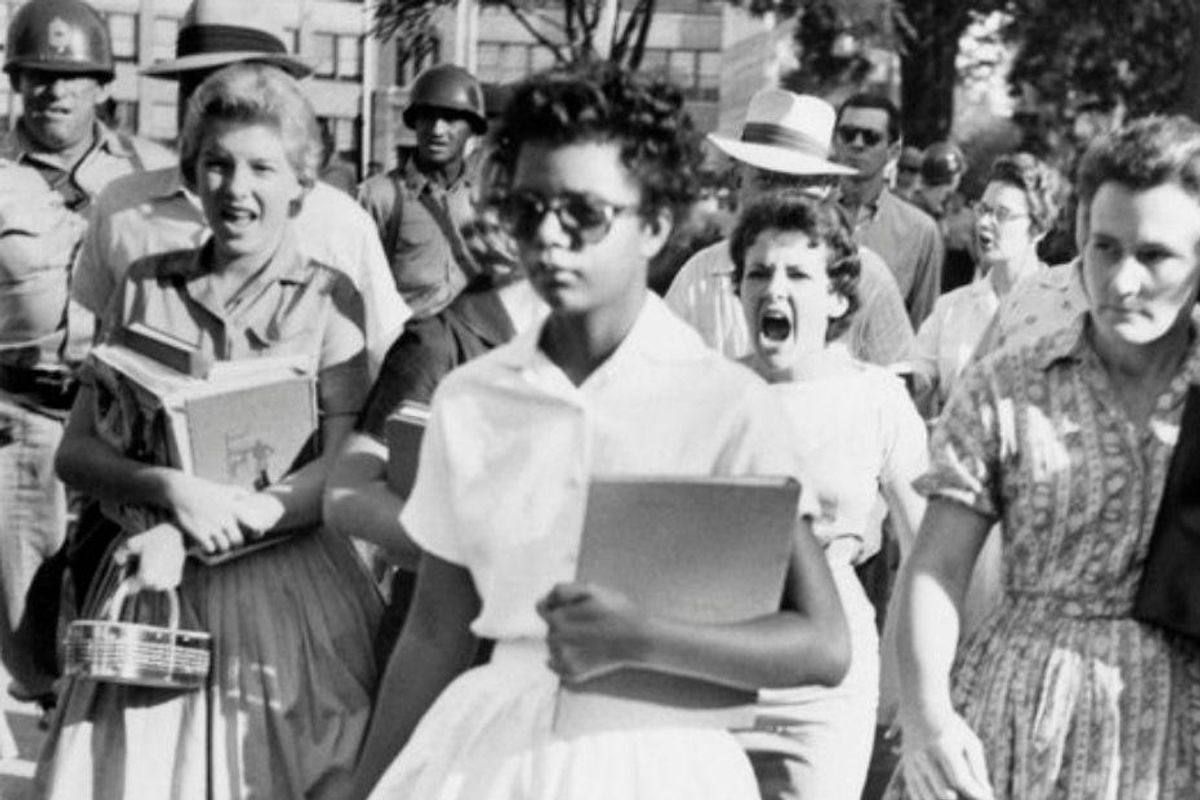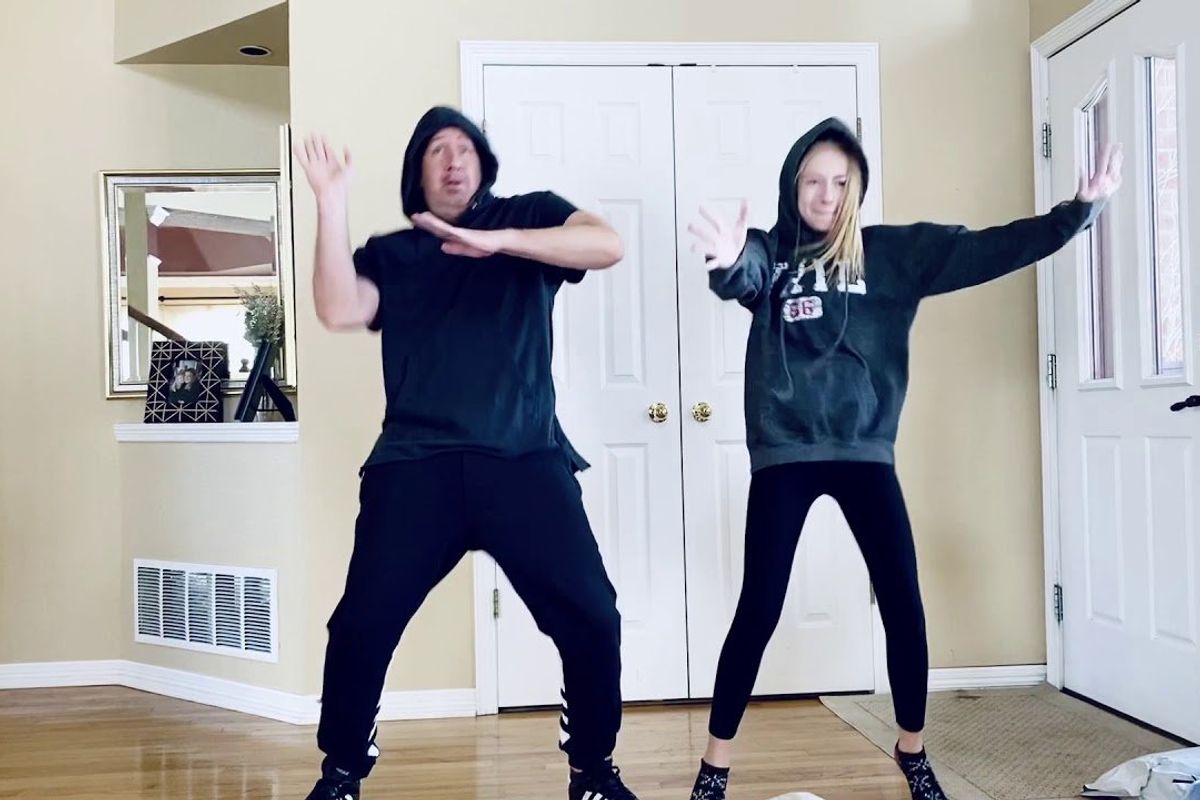Elizabeth Eckford made history at age 15. Here's the full story behind the iconic photo.
She faced the angry white mob—and the Arkansas National Guard—alone on her first day of high school in 1957. But that was only the beginning.

15-year-old Elizabeth Eckford was one of the Little Rock Nine who attended the first integrated high school in Arkansas.
On September 4, 1957, nine students arrived at Central High School in Little Rock, Arkansas for their first day of school. They were bright students, chosen for their academic excellence to attend the most prestigious school in the state. They were there to learn—and to make history as the first Black students to attend the previously all-white school.
They wouldn't enter the school that day, nor for weeks after. Their entrance was barred not only by an angry white mob but by the Arkansas National Guard who were called in by the governor to prevent the students from integrating the school.
Eight of the nine arrived together that first day in a carpool arranged by the local NAACP chapter. One student, 15-year-old Elizabeth Eckford, didn't have a telephone at home and was unable to be reached to learn about the carpool plan. She took the city bus, which dropped her off within two blocks of the school. As she approached, she faced the racist crowd alone.
One photo encapsulated much—but not all—of the moment. We see Eckford being followed by a group of angry white segregationists, but we can't see that they were yelling, "Lynch her! Lynch her!" We can see the Arkansas National Guard, but we can't see that President Eisenhower would have to call in federal troops weeks later to finally get the students into the building. We see Elizabeth Eckford walking with her head high, but we can't see the courage and resolve it took her not to walk through a crowd of people threatening to kill her just for wanting to go to school.
We see a snapshot of a horrific moment in American history, but we can't see what happened after.
On this third day of black history month let\u2019s remember the incredibly brave students known as the \u201cLittle Rock Nine.\u201d They were the first black students to attend Central High School in Little Rock, Arkansas.pic.twitter.com/IQeXhrCVWZ— Aliah Rowe \u2764\ufe0f (@Aliah Rowe \u2764\ufe0f) 1643908371
After being barred entrance to the school, Eckford tried to return home, but she was unable to go back to the bus stop where she'd been dropped off due to the 250 or so angry white people behind her. She decided to try to get to the next bus stop a block ahead of her.
Buddy Lonesome of the St. Louis Argus described what he had witnessed at the scene: "The mob of twisted whites, galvanized into vengeful action by the inaction of the heroic state militia, was not willing that the young school girl should get off so easily. Elizabeth Eckford had walked into the wolf's lair, and now that they felt she was fair game, the drooling wolves took off after their prey. The hate mongers, who look exactly like other, normal white men and women, took off down the street after the girl."
She would get home eventually. At first, she sat on the edge of the bus stop bench as someone yelled "Drag her over to this tree!" A small group of journalists formed a makeshift barrier between her and the crowd. New York Times reporter Benjamin Fine sat down next to her, put his arm around her and said, "Don't let them see you cry." Later, after being asked if he'd overstepped his professional bounds, Fine replied, "A reporter has to be a human being."
A white woman, Grace Lorch, escorted Eckford onto the bus, but not before she told the crowd that they'd all be ashamed of themselves someday. Eckford was relieved when Lorch got off the bus; her help, though undoubtedly well-intentioned, had only inflamed the hatred of the crowd. (Lorch and her husband would eventually move their family to Canada after facing harassment, job losses, and accusations of being communists for their civil rights activism.)
After exiting the bus, Eckford immediately went to find her mother. She fell into her arms and the two cried together, neither saying a word.
What about the student yelling at Eckford in the photo? Her name was Hazel Bryan—later becoming Hazel Massery. She was the daughter of parents who were unabashed about their racism.
Massery would have a change of heart in the years that followed. She became a follower of the civil rights movement and began to understand how wrong she had been. In 1962 or 1963, she called Eckford to apologize. But she didn't stop there. She left her intolerant church, volunteered with projects to serve underprivileged Black students and single Black mothers, read the works of Cornel West and Shelby Steele and argued about racial issues with her mother.
Eventually, Massery and Eckford realized they had a lot in common as individuals and became friends. They even appeared together on The Oprah Winfrey Show and talked about reconciliation. But the friendship did not last. The rest of the Little Rock Nine had never been fans of the friendship, nor of Massery's appearance at public events about their history. Massery seems to have felt frustrated that Eckford wouldn't absolve her completely of her past racist behavior, and she ultimately cut off ties with her.
Ten years ago, David Margolick, who had interviewed both women multiple times over the years, asked Eckford and Massery to pose together for one last photo. Eckford agreed, but Massery refused.
Both Eckford and Massery are still alive. Eckford celebrated her 80th birthday in October with a small celebration in front of Central High School, with student members of the Civil Rights Memory Project and faculty there to honor her. This is not history from some far distant era. People are alive who saw it happen with their own eyes.
And this isn't even the full scope of the story. The Little Rock Nine spent the school year being brutally harassed even after they were finally allowed into the building. And both Eckford and Massery's stories include many more details, which David Margolick has covered in Vanity Fair and Slate. His storytelling illustrates how the story behind the iconic photo is worse (at the time) and more complex (in the long run) than the simplistic narratives we often hear about the civil rights era and are definitely worth a read.
How does Eckford feel about the photo? She told the Arkansas Democrat-Gazette that she sometimes feels nothing when she sees it and sometimes it bowls her over. But she's never felt good about the photo, nor does she see herself in it the way others do.
"They talk about it as strength," she said, "But I've never considered myself a strong person."
Fair enough. No one should ever have to be strong like that in the first place, especially at 15. May we all remember and learn from this history, and keep working toward a future where racism is truly and fully overcome.
This article originally appeared on 2.5.22
- New Emmett Till memorial sign to be bulletproof because people ... ›
- The absolutely wild story from the civil rights movement you didn't ... ›
- 20 striking photos show the civil rights movement then ... and now ... ›
- Emmett Till's murder led Rod Serling to create "The Twilight Zone" - Upworthy ›
- Mom created first day of school photo of herself - Upworthy ›
- White mob rioted over James Meredith attending Ole Miss - Upworthy ›




 Even when there's no assigned seat, everyone knows where they usually sit.
Even when there's no assigned seat, everyone knows where they usually sit.
 Women walking down a street.Image via Canva Photos.
Women walking down a street.Image via Canva Photos.  Woman aware of her surroundings in a parking garage. Image via Canva Photos.
Woman aware of her surroundings in a parking garage. Image via Canva Photos.
 Season 3 Dancing GIF by Party Down
Season 3 Dancing GIF by Party Down  music video happy dance GIF by Apple Music
music video happy dance GIF by Apple Music 
 A boots story shows why it can be so hard to climb out of poverty.
A boots story shows why it can be so hard to climb out of poverty.  A good pair of work boots will save you money in the long run, but only if you can afford them in the first place.
A good pair of work boots will save you money in the long run, but only if you can afford them in the first place. More reliable cars cost more up front.
More reliable cars cost more up front.  It's hard to climb out of poverty when you can't reach the ladder.
It's hard to climb out of poverty when you can't reach the ladder.